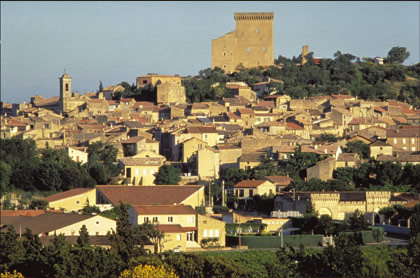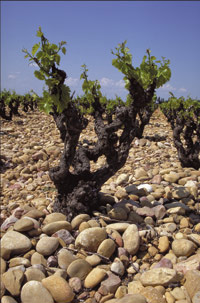Chateauneuf-du-Pape
Chateauneuf-du-Pape is undoubtedly the king among the wines of the southern Rhone. The other wines, the Cotes-du-Rhone Villages, the Rasteau, the Vacqueyras, or the Gigondas also have power, sometimes opulence, but in none of the other appellations can you find wines with a similar complexity, with a comparable mixture of power and refinement, of fire and restraint, of hedonism and intellectuality. No other wine is as perfect for a téte á téte by the fireplace as it is - very slightly chilled - for a summer barbecue, even if it can be quite dangerous for the latter. For all its power and complexity, good Chateauneuf-du-Pape can be an extremely uncomplicated drinking pleasure, which can quickly take its revenge if you indulge in it too lightly.
 |
| Chateauneuf-du-Pape% Source: Inter Rhone% Photo by Alain Gas |
There are a number of famous producers whose prestigious wines are traded at exorbitant prices. It's easy to forget that, in addition to the deservedly sought-after wines of the top producers, the region has a large number of excellent, often characterful wines from lesser-known houses that are generally affordable and can be seductive even in their youth.
Speaking of youth, red Chateauneuf-du-Pape is considered to be eminently storable and some of the best wines take several years to show their best side after an initial, overwhelming fruit phase. Some of them are capable of developing further over decades. But these late developers are actually rather in the minority. Most Chateauneuf-du-Pape taste best in their youth, when they are almost bursting with irresistible, mostly red fruit, when they are bursting with power and yet, because of their complex spice and often minerality, never seem clumsy. Most wines hold up quite well, but cannot retain the allure of their youth forever. They often become more rustic from the fifth to eighth year of life, noticeably losing charm and finesse.
So, apart from the big names, it was often the younger wines that we particularly liked. The older the samples became, the more the differences between the prestige wines of the respective producers and their basic wines became apparent, which sometimes started to show a certain age fatigue after only a few years. The main focus of the tasting was on the years 2000, 2001, 2003 and 2004. Hardly any wines were submitted from the catastrophic year 2002, with its huge floods in the area.
 |
| Where the wine grows% Source: Inter Rhône% Photo: Isabelle Desarzens |
The 2000 and 2001 vintages seemed almost equal to us, with perhaps a slight advantage in the often surprisingly cool and compact 2000s. In many cases, they still have plenty of potential, while the 2001s more often already give us plenty of pleasure. The 2003 vintage was obviously more difficult to master. The wines did not always find their balance. The tannins are often a bit coarser than usual and occasionally, despite very high alcohol levels, green notes appear. Most of the wines from 2004 are full and juicy, with a lot of beguiling fruit and an excellent structure, which should ensure an ageing potential of many years even for the basic wines.
A speciality largely unknown in our country is the white Chateauneuf-du-Pape, for which mainly the varieties Grenache Blanc, Clairette and Bourboulenc, but more and more often also Roussanne are used, while Picpoul and Picardin play a subordinate role. The white wine is also mostly very strong, but sometimes seems a bit one-sided when young, especially when the first fruit phase is coming to an end. The better examples, however, ripen significantly longer than one can imagine at a young wine tasting. They develop a beguiling aroma of dried yellow fruits, caramel, honey and spices after a few years of bottle ripening, during which they can appear so barren, forbidding and oxidised that one is inclined to write them off and dispose of them in the sink, without losing their bone-dry character. At least the best of the white Chateauneuf-du-Pape we tasted, those from Beaucastel, Domaine de la Solitude, Grand Tinel, La Gardine, and Chante-Perdrix, we definitely trust a similar development
Cotes-du-Rhone and Cotes-du-Rhone-Villages
The Cotes-du-Rhone, for whose production 22 different grape varieties may be used, is a prototype of the uncomplicated red wine for every occasion. As a simple accompaniment to a meal, a snack, a barbecue or a convivial evening: the choice of a Cotes-du-Rhone is almost always right, due to its mostly uncomplicated and open-hearted nature. Although there are around 10,000 producers and an incalculable number of different bottlings in this huge area, which extends over large areas of the Southern Rhone, but also includes vineyards in the Northern Rhone growing region, gross disappointments are surprisingly rare. Indeed, there are hardly any top wines, but the level is mostly decent to good, often very good, and the prices are very attractive. So it is hardly a problem to buy a really good Cotes-du-Rhone for less than 7 euro. The white wines are also overshadowed by the reds here, but it's worth looking out for the best ones. They sometimes develop better with age than their red counterparts.
 |
| Château Grillet% Source: Inter Rhône% Photo: Isabelle Desarzens |
The Cotes-du-Rhone Villages, which only exists in the southern Rhône, is subject to much stricter standards, both in terms of origin and harvest quantity and the grape varieties used. This not only makes it more reliable in terms of quality and character, even if the wines are of course not always necessarily better than simple Cotes-du-Rhone. The restriction of the cultivation area to better sites, however, also allows the production of top wines, which are hardly found in the simple appellation. A whole series of villages has earned the right to use the name of the village on the label in addition to the name of the appellation by producing reliably good qualities. Really good representatives of the Cotes-du-Rhone Villages can compete with a Vacqueyras or Gigondas, but their price is not necessarily lower.
Our favourites: